| Botanical Name |
|
| Family |
Hyacinthaceae - The hyacinth family. |
| Pronunciation |
velt-HIME-ee-uh brak-tee-AY-tuh |
| Common Name(s) |
|
| Plant Group |
- Bulb / Corm / Rhizome / Tuber / Epigeal bulb Bulbs: are made up of fleshy scales as in an onion
Corm: a short, swollen, underground stem that is hard and not fleshy as in a gladiolus
Tuber: a solid, fleshy, underground, storage organ as in a potato
Rhizome: an underground, horizontal, swollen stem at the base of the plant as in an iris
Epigeal bulb: bulbs that rest above the ground with only the roots anchoring the plant to the earth as in albuca
- Ground Cover A plant with a low-growing, spreading habit, grown specifically to cover the ground.
|
| Plant Size |
- Small to Medium
| Tree | 8m to 15m |
| Shrub | 75cm to 1m |
| Perennial/ground cover | 20cm to 40cm |
| Bulb | 30cm to 40cm |
| Succulent | 20cm to 40cm |
|
| Position |
- Canopy Shade Canopy shade is found below closely grown trees where some light filters through. Ideal for the protection of herbaceous plants.
- Deep / Full Shade Shade below spreading evergreen trees where sun's rays are unable to penetrate the canopy at any time. For light sensitive plants
- Light or Dappled Shade Found below trees with sparse, open foliage. Ideal for the protection of herbaceous plants.
- Partial Shade The area is in shade for part of the day and in full sun for part of the day.
|
| General Information |
- Deciduous to Semi-deciduous In warmer areas a deciduous plant may not lose its leaves during winter at all, or may lose its leaves for a very brief period, or may only lose part of its foliage.
- Frost: Half-hardy The plant is able to survive low temperatures and some frost but requires protection against severe frost.
- Sand tolerant Plants adapted to survive in nutrient poor, very sandy soils.
- Water Wise Plant species originating from low rainfall regions that require less water to survive and thrive than other plant species.
|
| Specific Information |
Veltheimia bracteata has long lasting, flowers and attractive undulating leaves arranged in a rosette. Veltheimia will endure light frost as long as they are protected from the morning sun by overhanging branches. I have seen this plant grow equally vigorously in a garden in Pretoria, and in wild bush near the beach in Port Alfred. The plants are briefly dormant during mid-summer.
|
| Ad Break |
|
| Flowers |
| Description |
tubular, drooping flowers on a stalk up to 60 cm long - much akin to red hot poker and aloe
|
| Season |
- Winter to Spring Plants will seldom bloom for the entire season as given in the list, but should flower during a period within these parameters.
|
| Colour |
|
| Growth Rate |
- Moderate Specifying growth rate can be very misleading as there is considerable variation of growth rate depending on type and species of plant, available water, supplementary feeding, mulching and general care, as well as the plants suitability and adaptability to the garden environment.
|
| Plant Uses |
- Accent or Focal Point A plant used to attract the attention because of its colour or form.
- Attracts bees, butterflies or other insects This plant attracts insects which can be food for birds or other creatures in your garden.
- Container Trees, shrubs and ornamental species that can adapt to growing in a restricted environment.
- Cut Flowers Plants that provide flowers suitable for ornamental uses.
- Mass Planting Plants useful for filling a large area with just one or a few kinds of plants spaced close together. Creates a bold, dramatic effect and to reduces maintenance.
- Pot Plant A plant that needs a protected environment on a patio or indoors.
- Suitable for coastal gardens Plants adapted to dry, sandy soil, forceful wind, limited rainfall and intense sunlight.
- Suitable for smaller gardens Such plants do not have invasive root systems, remain small or controllable and can often be grown in containers.
- Water Features These plants may have dramatic, lush foliage or graceful form. They do not shed excessive leaves and do not have invasive root systems.
- Wild Garden An indigenous garden planted for the benefit of wildlife and birds. Provides food, water, a variety of mini-biomes and no poisonous chemicals are used.
|
| Distribution and Habitat |
Eastern Cape and KwaZulu-Natal, in forests
|
| Planting Suggestions |
Veltheimia bracteata grows best in shade or semi-shade. For best results, prepare well-drained soil thoroughly by digging in compost and fertiliser to a depth of about 45 cm. Transplant the bulbs from January to March. Plant the bulbs at or just below the soil surface. Water well until the bulbs are established and again when the bulbs are flowering. Once planted, the Forest lily should be left for some years before being lifted. Be on the lookout for snails and slugs.
|
| Lorraine's Garden Notes |
I have never bothered to prepare my soil or fertilise these bulbs and they flower and multiply quite happily, despite my nutrient poor, alkaline soil and frequent bouts of drought.. I do however keep the bed covered with a deep layer of fallen leaves.
|
| Medicinal Uses |
There appear to be no references to Veltheimia bracteata being used medicinally in South Africa.
|
| Ad Break |
|


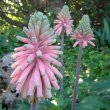
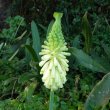
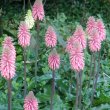
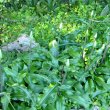
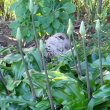
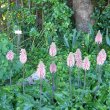
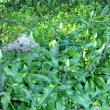


Comments
Veltheimia-bracteata
Good day,
I am living in Komatipoort, Mpumalanga. I was given bulbs of the veltheimia plant (I do not know which one of them) from a garden in Benoni, Gauteng. As you are aware there is a great difference in climate. I have planted the bulbs in pots on my patio and they have been doing very good. My ultimate destination for them would be in my garden in mottled shade under the trees. However, I note that they are busy losing their leaves and this causes great concern to me, as I do not know anything whatsoever of these plants. I am confused with the behaviour of the plants as we do not really have a winter here, so do not know when to expect them to become dormant or when they are expected to flower. Please, under the circumstances, give me advice. These plants are very dear to me as I got them from a cousin who has since passed away. I would love to have a great show of them in my garden, ultimately. Thanks for this website, it is very informative and I am going to make lots of use of it.
Regards, Maggie van der Merwe.
Discuss this plant
Share knowledge, ask a question or give an experience.